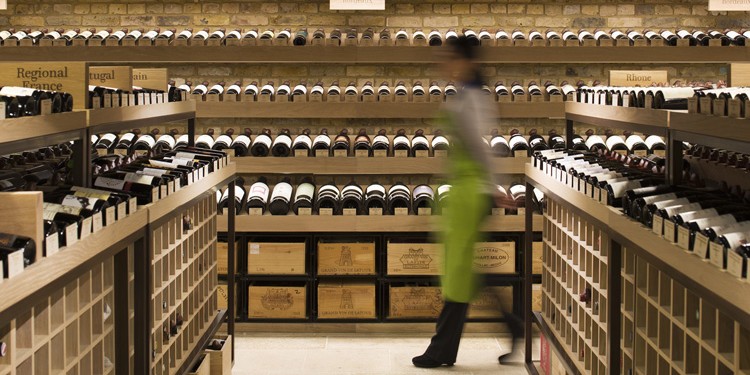
Italian wine in UK

by David Gleave MW
Some curious things to know about the business of Italian wine in UK market
I have been working in the UK wine trade for over 30 years, and have spent much of that time selling Italian wine. I remember well how difficult it was to try to sell more expensive and premium Italian wines in the 1980s and 1990s, when people would smile sympathetically as you presented to them a Chianti Classico from Isole e Olena or Fontodi and say: “I can get a Chianti much cheaper than that.” I would shrug my shoulders and go off in search of someone – that rare person, back then – who was more interested in the quality of Italian wines rather than their price.
So imagine my surprise when a young French sommelier approached me last year at one of our tastings. “You are so lucky to be selling Italian wines,” he said. “Everyone wants to drink them.” I smiled and replied that yes, I was lucky to be selling Italian wines. But when our conversation came to an end, it gave me cause to reflect on just how much the market for wine – and not just Italian wine – has changed in the past two decades.
In 1990, New World wines (those from Australia, the USA, South Africa, New Zealand, Chile and Argentina) accounted for only 5 bottles of every 100 sold in the UK; today, they account for over 50% of the market. Australia is at the top of Seria A with over 20% of the market, and the USA is in third with about 17% of overall sales. As a young wine buyer back in 1990, I spent a lot of time ensuring that I had a good portfolio of inexpensive German wines, as Germany and France dominated sales in the UK market. Italy, much to my dismay at the time, was very much the poor cousin. If sales of Lambrusco (white, red, pink, low alcohol – whatever style the UK supermarket buyers wanted, in other words) had been deducted from overall Italian sales, there wouldn’t have been much left over.
Such was the domination of Lambrusco that Nicolas Belfrage wrote a book in 1985 entiteld ‘Life Beyond Lambrusco’. The book was a serious and in depth look at Italian wines and its best producers, and was a plea to wine buyers and drinkers to take Italian wines more seriously. Such was the quality of the book that it certainly played a large part in changing perceptions about Italian wine. And once perceptions changed, people were willing to experiment with Italian wines. Once tasted, they often decided to experiment further, something which has led, over the past 20 years, to a big increase in sales of Italian wines. Today, Italy sells more wine in the UK than France, even if the average value of French wines is higher in both the on and off-trade. Italy is number two in the league table, ahead of the USA but behind Australia.
Going from a league table in 1990 where France and Germany dominated, to one where Australia, Italy, the USA and France now lead the pack, is a bit like imagining Seria A being dominated by Catania, Sassuolo and Genova in 2034, with only Juventus still at or near the top. It has been a remarkable transformation, and one that makes it exciting to be selling wines in the UK.
So how does this fast changing market work? As in most other markets, the supermarkets are taking an ever larger slice of the market. Two decades ago, the UK had some exciting and very good wine shops who could rival what the supermarkets offered. Chains like Oddbins, Thresher, Wine Rack, Majestic and others were thriving, while the independent merchants (the enoteche) were being squeezed between the power of the supermarkets and the energy and innovation of Oddbins. Slowly, however, the supermarkets clawed market share away from the chains. Today, only Majestic is still going strong, while the others have changed ownership and are much smaller than they used to be.
As the supermarkets no longer need to compete against vibrant operators like Oddbins and Thresher, they have reduced the number of wines on their shelves and increased the number of wines they sell on promotion. It is a simple approach that has been embraced by the consumer, even if the wine critics lament the lack of diversity on display. This change in the market has had an unintended consequence: the revival of the independent wine merchant. There is now more wine available than ever before, yet ironically fewer places in which to sell it. This has given the independent wine merchant much greater choice of wines that aren’t available elsewhere. While this may only appeal to 5% of the market, that market is worth over 72 million bottles of wine a year. If, for instance, I were producing wine in Italy, I would be looking for an importer who could sell my wines to the independent wine merchants around the country.
That is the ‘off-trade’, which accounts for about 82% of all wine sold in the UK. The average selling price is just over £5 a bottle, so there isn’t much margin there for producers or importers. But the consumers, buying well over 70% of their wines on promotion, are very happy with the situation.
The other 18% of wines sold in the UK is sold through the on-trade, restaurants, hotels, pubs and the like. Until the late 1980s, this sector of the market was quite dull: pubs sold mostly beer and whisky and a little bit of very poor wine, whereas restaurants were by definition ‘French’, and the only wine that was ‘fine’ was also French. The local Italian restaurant sold a caricature of what was Italian food, and all other restaurants (Indian and Chinese) sold beer and inexpensive wine. Indeed, someone once commented that they only way to eat well in the UK at that time was to have breakfast three times a day!
This has changed dramatically. London is without doubt one of the most exciting restaurant cities in the world. The growth in premium restaurants in the past two decades has been nothing short of startling. The diversity of food on offer is equally as startling, and this has led to much greater interest in premium wines. And just as the food is often influenced by a wide range of countries, so do the wine lists offer remarkable diversity. My company imports from 17 different countries, yet some of our competitors import from over 20 different countries (including India, China, Georgia, Brazil, Canada and others).
Whereas 20 years ago, the on-trade was dull and uniform, and the off-trade was full of dyanmism, today the on-trade is the most exciting place to sell premium wines. Many specialist importers have set up to sell directly to restaurants, who also pay their bills much better than they ever used to! Within the on-trade market, Australia moves from the number one position it holds in the off trade to number three. Italy is number two, but France is number one, and has grown by 10% in volume over the past 12 months. This illustrates quite clearly how the consumer’s spending habits change when they go from a supermarket to a restaurant.
There are two other aspects to the wine market in the UK that are fast changing and exciting. The first is the traditional ‘broker’. These companies, led by Farr Vintners, buy wines directly from the producer in Bordeaux, or from importers, or direct from private collectors who want to sell their cellar. They sell not only in the UK, but to private and trade customers around the world. Farr Vintners, along with several other merchants, has an office in Hong Kong, while Berry Brothers, who have been selling wine in St. James in London for over 300 years, have just opened up in Singapore.
While the brokers are a reminder of Britain’s long dominance in wine trading, the internet merchants are a sign of things to come. Most wine merchants, and many supermarkets, have a diverse online offering. There are some specialists, like Slurp, who have developed a range of wines solely for their customers who buy over the internet, but most merchants regard the internet as another means of selling to their customers. It has also brought a great deal of transparency to pricing, and ensured that customers now shop around for the best deal rather than relying on their merchant for a regular supply of wines. This in turn means that the merchants are forever on their toes, as the consumers are more demanding than evern. But this also means that the UK remains a tough and competitive market, but one in which it is a pleasure to sell a wide range of wines at an even wider range of prices.
Long may it last!
See also ...


The battle continues with the new Chianti Gran Selezione
On 11th November, the Chianti Wine Consortium announced Read more


Changes at the top in Genagricola and Santa Margherita
Big news in Genagricola and Santa Margherita Gruppo Read more


Pinot Grigio delle Venezie: the first national conference
The curtain will rise on the new appellation Read more
